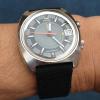Twisted Stem?
-
Recently Browsing
- No registered users viewing this page.
-
Topics
-
Posts
-
By HectorLooi · Posted
I'm currently working on a Citizen 4520 movement. This has to be the smallest and weirdest quartz movement I've ever worked on. Firstly, it's small. Really small. Here's a picture of it next to a LR44 battery for comparison. And unlike conventional quartz movements, the construction of this movement is really weird. The moment I took off the top plate, the rotor and 1st wheel are exposed. The PCB is right on the bottom plate. There are no dial side components and cover plates. Everything goes in from the rear. Not sure if I'm able to fix this watch. The old battery leaked and there are battery juice crystals everywhere. And there is a 1 uA constant leakage current, which will drain the tiny battery in no time. But at least there's still a pulse and the rotor twitches. -
Afraid this is where it could get down to old school adjustment and observation. There are pallet setting tools..but the calibrated ones aren't cheap. The observation holes in the plate will allow you to see if you have one or both stones hanging up/ not engaging on a tooth, That would ofcourse require you to disassemble, heat/move the jewel in/out as required..by eyesight and experience. It's truly trial and error until you get close enough that you could make small adjustments with the banking pins until they drop to the lock freely. You can use a Potence tool to help hold the rok in place during reassmbly. Here's a pic of one...made with a piece of old 18s mainspring You just fold over a roughly 2 inch piece, then file a slot on the end that engages the pallet fork arbor
-
Haha, tell him you're supposed to fill the pool with water before diving.
-
That could be another sign it's up for some TLC. Perhaps too much, too little, or the wrong type of grease was applied to the barrel walls. Perhaps it occasionally slips too much, which could explain the funny initial timing machine readings. Thanks for the input! On second thought, probably not, as it was doing perfectly 24 hours later... Hmm... Perhaps there is some debris floating inside, getting caught and uncaught between some teeth and pinion leaves!? If there is one thing I’ve truly learned over the years, it’s that you must be extremely meticulous about cleanliness and observant of different types of debris that can end up in the movement, such as dust, skin flakes, clothing fibers, etc.
-








Recommended Posts